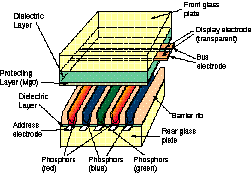New Plasma Display Panel (PDP) Technology shows the way to HDTV
A new PDP structure and drive method technology allows HDTV resolution to be achieved. Two recent demonstrations have shown Flat panel displays with apparent High Definition resolutions. Flat panel displays are one of the key enabling technologies required to herald the new era of Digital High Definition Television.
Fujitsu has developed a revolutionary new technology, called "Alternate Lighting of Surfaces" (ALiS), for high resolution PDPs suited for High-Definition TVs (HDTV). ALiS method incorporates a new PDP panel structure and drive method that displays up to 31.5 million dots, more than 1000 scan lines and double the brightness.
Fujitsu displayed a prototype 42-inch high resolution colour PDP for HDTV incorporating the ALiS method at the Fujitsu Electronic Device Solutions '98 exhibition, on 27th August in Tokyo.
 A similar Panasonic device was displayed in Australia in mid August (11-13th) at the FACTS engineering committee AGM. Many exhibitors were showing 42 inch flat panel displays of 480x850 type resolution, however the Panasonic display was noticed as standing out from the rest in resolution. Colin Wright (Seven) commented "When fed with high quality material (HD5) through a display converter unit, most of the viewers were convinced they were watching HDTV or pictures as good as you would ever want in your living room."
A similar Panasonic device was displayed in Australia in mid August (11-13th) at the FACTS engineering committee AGM. Many exhibitors were showing 42 inch flat panel displays of 480x850 type resolution, however the Panasonic display was noticed as standing out from the rest in resolution. Colin Wright (Seven) commented "When fed with high quality material (HD5) through a display converter unit, most of the viewers were convinced they were watching HDTV or pictures as good as you would ever want in your living room."
Brian Powell of the ABC examined the construction of the panels with his magnifying glass and noted that each row had 2 fine horizontal stripes between the rows. It is believed that this display is an example of the next generation of PDP displays which incorporate the ALiS technology. Ross Henderson of Matsushita Australia has indicated that the Panasonic display was manufactured and developed by Mitsubishi independent of Fujitsu. The Panasonic display panel is currently in production. At the demonstration a figure in excess of $18,000 was quoted for this panel.
 The ALiS method improves on the standard
Three Electrode Surface Discharge method that is the basic technology for
Fujitsu's PDP products.
The ALiS display method makes two scanning lines with one set of display electrodes (R, G & B). The two front electrodes are placed toward the top and bottom of each plasma cell instead of being over the middle of the pixel. They are alternately energised to provide a graded pixel intensity at the top and bottom of the cell. This effectively synthesises two lines from a single line of plasma cells, thus providing an increased line count and perceived resolution. It is interesting to note that this is an interlace display technology which complements the HD interlace display formats.
The ALiS method improves on the standard
Three Electrode Surface Discharge method that is the basic technology for
Fujitsu's PDP products.
The ALiS display method makes two scanning lines with one set of display electrodes (R, G & B). The two front electrodes are placed toward the top and bottom of each plasma cell instead of being over the middle of the pixel. They are alternately energised to provide a graded pixel intensity at the top and bottom of the cell. This effectively synthesises two lines from a single line of plasma cells, thus providing an increased line count and perceived resolution. It is interesting to note that this is an interlace display technology which complements the HD interlace display formats.
The new ALiS technology facilitates the creation of large-size HDTV screens and high-resolution image displays. Fujitsu has applied for over 10 patents, including basic patents, related to the new PDP structure and drive method technology.
Characteristics of the ALiS method:
- The ALiS method allows display of HDTV specification broadcast (1,000 or more scan lines) with almost the same number of display electrodes and drive LSI chips as the current generation of 42-inch colour PDPs.
- The prototype device achieves a luminous intensity of 500 cd/m2. Almost twice the degree of brightness compared to the current model.
- Due to the simple display cell structure, existing mass production technology and panel processes can still be used.
The Fujitsu ALiS method prototype PDP specification:
- Screen size: 922.2 mm x 522 mm (diagonal 106 mm, 42-inch)
- Screen ratio: 16:9
- Pixels: 1,024 x 1,024 (3,145,728 dots)
- Pixel pitch: 0.9 mm x 0.51 mm
- Luminous intensity: 500 cd/m2 (white light peak)
- Contrast: 250:1
- Display colours: 16,770,000 colours
- Electric consumption: 250W (typical)
Information for this news item was drawn from the following sources:
M2 communications, Fujitsu, Seven, Matsushita, Panasonic, Pioneer, Sony, FACTS and was prepared by Neil Pickford of the Communications Laboratory.
Last update 11/09/98
 A similar Panasonic device was displayed in Australia in mid August (11-13th) at the FACTS engineering committee AGM. Many exhibitors were showing 42 inch flat panel displays of 480x850 type resolution, however the Panasonic display was noticed as standing out from the rest in resolution. Colin Wright (Seven) commented "When fed with high quality material (HD5) through a display converter unit, most of the viewers were convinced they were watching HDTV or pictures as good as you would ever want in your living room."
A similar Panasonic device was displayed in Australia in mid August (11-13th) at the FACTS engineering committee AGM. Many exhibitors were showing 42 inch flat panel displays of 480x850 type resolution, however the Panasonic display was noticed as standing out from the rest in resolution. Colin Wright (Seven) commented "When fed with high quality material (HD5) through a display converter unit, most of the viewers were convinced they were watching HDTV or pictures as good as you would ever want in your living room." The ALiS method improves on the standard
The ALiS method improves on the standard